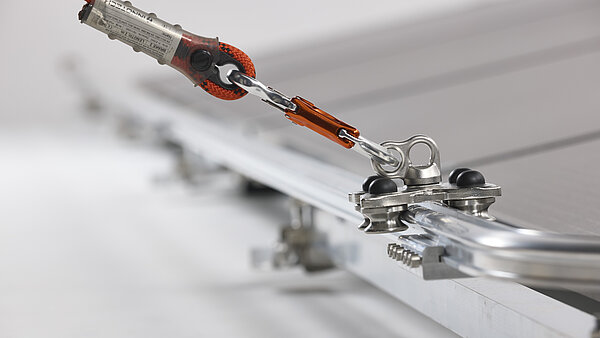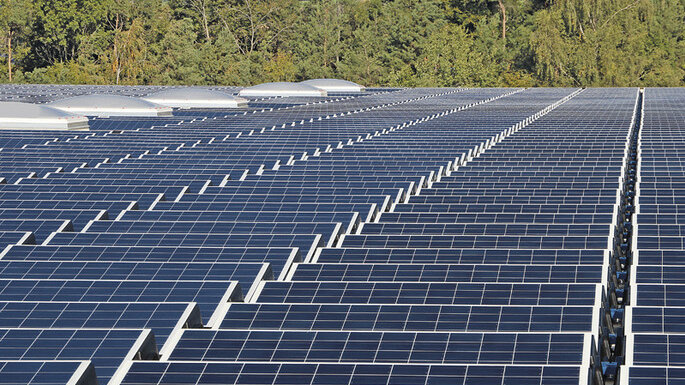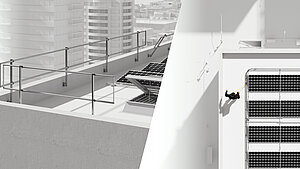With regard to PV installations on roofs, the question of competition for area often arises. This refers to competition between various types of use for the available area. The reason is that in principle all PV system operators want to free up the maximum possible amount of space for their solar power plant. But here, pitched roof inclination, skylights, chimneys, satellite dishes, and air conditioners on the roof have to be taken into account, as indeed do clearance spaces for the fall protection system, and separations necessary to prevent shading and provide maintenance routes.
However, in this discussion with Michael Duss, who has been Marketing Manager for Utility Roofs – roof greening, fall protection, and photovoltaics – at BAUDER since 2013, we learn that the term “competition for area” is misleading in practice, and is therefore not be used. In 2018 the family company BAUDER, renowned for high-quality, safe roofs which are long-lasting, good value, and sustainable, enhanced its product range with fall protection systems from INNOTECH. The two family-led companies cooperate particularly in marketing and product development.
BAUDER is the exclusive partner for roof applications, and INNOTECH focuses on markets such as industrial applications, building envelopes, etc. In the interview which follows, Michael Duss gives us insights into his approach when it comes to using the available space on the roof for solar panels – in the best possible way, and in the greatest possible safety.
When you hear the term “competition for area”, what do you think?
In itself, I find the term rather misleading, and therefore incorrect. When considering the roof surface holistically, the questions which arise should already be resolved during the planning phase.Let us first of all clarify which data is relevant: Wind and snow load zone, ground category, roof inclination and roof substructure, parapet height, and the fall protection system. On flat roofs with gradient insulation, not every ridge and valley of the insulation can simply be built over with PV equipment. All these items are therefore important. However, my sense is that the matter often boils down to a conflict of objectives between - supposed - maximum usage for PV and allowing clearance spaces for the fall protection system. Further separations e.g. because of shade or for maintenance routes also have to be complied with. If the flat roof is also to be greened, then substructures which stand higher and further horizontal row separations need to be taken into account.
In your opinion, what are the greatest challenges on flat and pitched roofs? And what part does the roof size play in this?
My experience shows the difficulty of making a sweeping statement in this regard. Small or narrow flat roofs can certainly present a challenge in terms of usage. Let’s take the example of an intensively greened flat roof with a PV system. So that the vegetation can develop, the modules should be installed at a distance of at least 30 cm between the eaves and the planting – of course, there are systems such as “BAUDER SOLAR G LIGHT” for this. Here the row separations of the modules should also be greater than for PV systems which are installed to lie flat. We recommend at least 80 cm for this. This alone means a reduced number of modules on the roof. Increased edge distances, e.g. for fall protection, can equally reduce the surface available for the PV system. Our specialists from Marketing or Application Technology have an open discussion with our customers about the subject; in the end they naturally make different choices.
How does this conflict of objectives, PV performance versus safety, affect the selection of the respective fall protection system?
As I already explained, this affects the fall protection system in different ways. We are not always included in the final decision process with the end customer. Where I was directly involved, I always have a positive recollection of discussing the facts about fall protection. Solutions can always be found then. Unfortunately, on occasions I heard that the safety measures took second place to installing a greater number of PV modules. To my mind, that is the wrong approach.
How can fall protection systems contribute to the optimum use of the roof surface for a PV system?
Obviously: the less space available for the PV installation is used up by the fall protection system, the better. The decision whether to use railings or a lifeline system always depends on the actual situation onsite. In this case, as already stated, several aspects should always be taken into account equally – the situation on the roof itself, the performance of the PV system, and maximum possible safety on the roof. We work together with our partner INNOTECH on new technical solutions. We too see that the PV market is growing by leaps and bounds, and so the requirement for fall protection systems is also growing.
In your opinion, what is the role played here by the holistic planning of PV systems which include a safety concept?
If the fall protection system is planned just before the start of the sealing work, it can then be difficult to find a suitable solution; especially if all roof systems or even the installation of the modules have already been specified. As said at the start, dealing with this as early as the planning phase makes a great deal of sense, and is what we recommend. Because: if the PV system’s kWp output has already been planned, then modifications – i.e. a reduction in the system’s size – are difficult. With some railing systems there are synergies; shorter booms can also help. However, some things are simply a given, and cannot be changed – such as maintenance routes or distances because of fire protection requirements, to name just two examples.
What is required so that roof surfaces can be used as efficiently as possible for PV systems without overlooking the subject of safety?
I hope that the number of assessments in advance continues to increase, because there are so many participants, such as structural architects, landscape architects, specialist electrical planners, building services planners, general contractors, roofers, roof planters, solar system installers, and health and safety protection coordinators. As an industry, we are happy to participate in this, and we also have the know-how to do so. I don’t just mean the areas of PV and fall protection, but of course also everything related to roofs. A particularly current topic here is rainwater management on properties, and therefore on the roofs. These require defined green roof structures, nowadays often also in combination with the PV system and fall protection. This can in turn affect the statics, connection heights, implementation details, and even the entire roof layer structure.

We work together with our partner INNOTECH on new technical solutions. We too see that the PV market is growing by leaps and bounds, and so the requirement for fall protection systems is also growing.
Read moreWe work together with our partner INNOTECH on new technical solutions. We too see that the PV market is growing by leaps and bounds, and so the requirement for fall protection systems is also growing.
About BAUDER
BAUDER is a family-led company with more than 150 years of history. Today BAUDER represents especially high-quality, safe roofs – long-lasting, good value, and sustainable. Almost all roof layers – from the moisture barrier, PIR insulation, seals made from various materials, to greening, solar energy, and the fall protection system addressed here – can be planned and used as one system from a single source. In addition, BAUDER is also characterised by closeness to our customers and employees; this is important for our long-term success.Today Paul BAUDER GmbH & Co. KG in Stuttgart, with more than 1,250 employees, is one of the leading roof system manufacturers in Europe.
As a fourth-generation family firm, BAUDER advises architects, planners, and installers expertly and, thanks to our extensive range of products, we have the right system solution for every roof. So ideal roof structures are provided from a single source – starting with the insulation, to sealing systems, utility roof structures with roof greening, photovoltaic equipment, and fall protection. This gives planners, property owners, and installers the certainty of making the best decision for the roof. In addition to the main factory and administration in Stuttgart, there are seven more factories in Bochum, Herten, Landsberg near Halle, Achim near Bremen, Bernsdorf, and Schwepnitz near Dresden, as well as Bruck an der Leitha near Vienna. Six sales groups in Germany and distribution companies in 16 countries ensure closeness to our customers.
If you want to find out more about this subject, you should contact our experts now. They will team up with you to find the optimum fall protection for the PV system on your roof. Our authoritative guide to fall protection for PV systems on a roof is available here, free of charge.
Photo rights: Reference Stockach Paul BAUDER GmbH & Co. KG








![[Translate to Englisch:] [Translate to Englisch:]](https://www.innotech-safety.com/fileadmin/_processed_/1/a/csm_Mehrere_PV-Kunden_gleichzeitig_betreuen__kann_oft_zur_Riesenherausforderung_werden-header_c1a520d846.jpg)




















